Instant Connection for Pixel Streaming
— New Feature Automated Setup





Top AI Tools for Model Generation on Blender 3D
Top AI Tools for Model Generation on Blender 3D
Top AI Tools for Model Generation on Blender 3D
Published on October 16, 2024
Updated on January 2, 2026
Table of Contents
The world of 3D modeling has been transformed by the integration of artificial intelligence (AI). This shift is particularly evident in Blender 3D, a popular open-source software that has embraced AI to enhance its capabilities. AI tools in Blender are becoming essential for artists looking to accelerate their 3D workflows. AI tools have revolutionized the way models are generated, making the process faster, more efficient, and accessible to a broader audience.
Blender is becoming increasingly versatile and accessible, whether you're working from a high-performance PC or even modeling on an iPad, there are now more ways than ever to integrate it into your creative process.
For those who may not have the time or desire to master complex modeling techniques, AI tools offer a powerful alternative. They allow users to create high-quality models without the steep learning curve, significantly reducing the time spent on manual tasks. Whether you're a beginner or a seasoned professional, these tools can streamline your workflow, enabling you to focus on creativity rather than technical details.
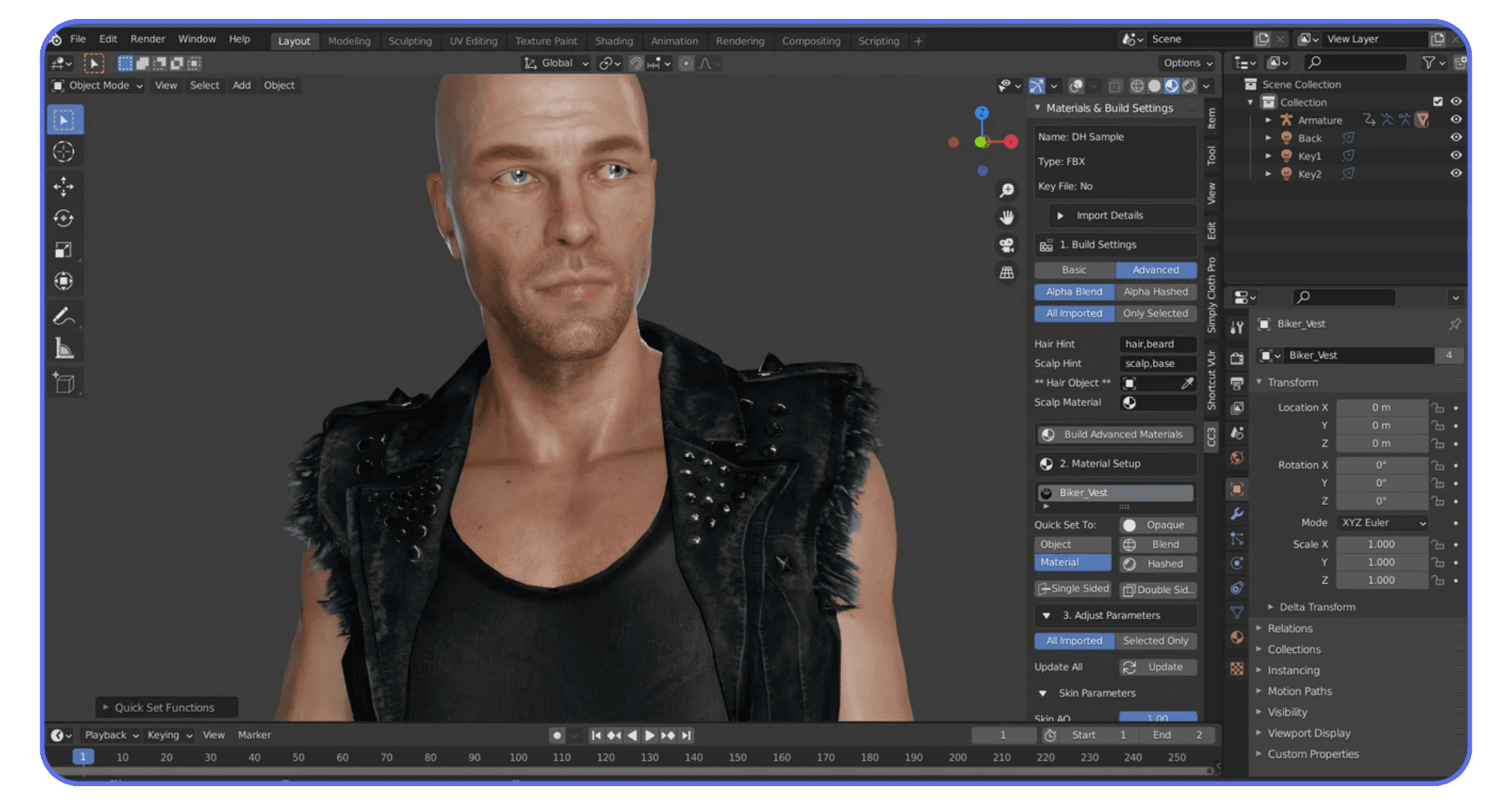
Overview of the Top AI Tools
Blender 3D’s versatility is greatly enhanced by several AI tools that integrate seamlessly into its ecosystem, making the modeling process more efficient and accessible. The KeenTools Blender Pack, for example, offers powerful facial tracking and 3D head model generation, which is invaluable for character designers and animators. The Blender Text to 3D AI Generator allows users to transform text prompts into 3D models, eliminating the need for complex manual modeling. Pic To 3D Mesh converts 2D images into detailed 3D meshes, simplifying the creation of complex models from references. Meanwhile, Meshy AI excels in procedural generation, enabling the creation of intricate designs with minimal input. These tools not only streamline workflows but also open up new creative possibilities for both novice and expert users alike.
List of AI Tools
When it comes to AI tools optimized for Blender 3D, each offers distinct features that cater to different aspects of the modeling process. Here’s a closer look at some of the top contenders:
Meshy AI
Meshy AI is a cutting-edge tool designed to simplify the creation of 3D models and textures using AI. As an advanced AI Blender model generator, Meshy AI allows users to quickly generate assets from text or image prompts and export them directly to Blender with minimal manual setup. It offers a range of features, including the ability to generate 3D models from text prompts and images, and automatically apply PBR (Physically Based Rendering) maps for realistic results. This tool is particularly powerful in Blender, where it integrates seamlessly, allowing users to export models in various formats such as FBX, OBJ, and BLEND.
One of Meshy AI’s greatest strengths is its speed and user-friendliness. The tool is designed to produce high-quality 3D assets quickly, making it ideal for both professionals and hobbyists who need to streamline their workflow. With its simple interface, even users with limited experience in 3D modeling can achieve impressive results. The ability to texture models without the need for UV mapping is another standout feature, saving users significant time and effort.
Meshy AI's unique selling point is its versatility and efficiency. Whether you're looking to create game assets, digital art, or architectural visualizations, Meshy AI provides a fast and effective way to bring your ideas to life. The tool's ability to generate and texture models with minimal input makes it an essential addition to any Blender user’s toolkit.
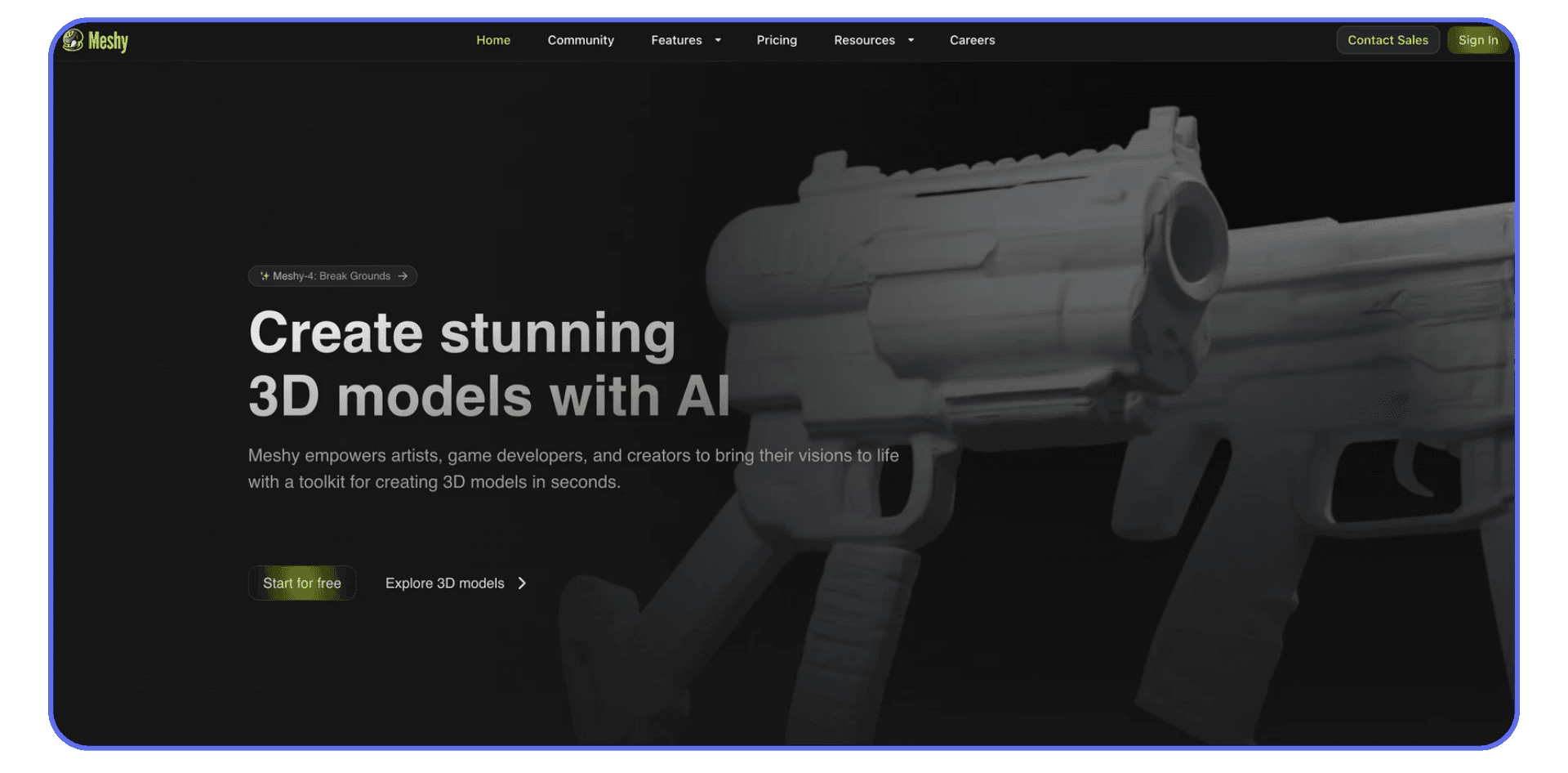
2026 Technical Update: Meshy AI’s latest release introduces GPU-accelerated model generation pipelines with improved inference times across NVIDIA RTX and Apple Silicon hardware. The tool now supports fully automated PBR material generation with real-time preview, eliminating the need for manual UV unwrapping. Export formats include updated support for GLB in addition to FBX, OBJ, and native BLEND, streamlining integration with Blender’s Asset Browser and Geometry Nodes workflows.
Create 3D Avatars from 2D Faces
Creating lifelike 3D avatars from simple 2D photos used to be a complex task, but with the latest AI-powered tools, it’s now easier and faster than ever. These innovative solutions take your selfies or reference images and transform them into detailed, customizable 3D models ready for animation or integration into Blender projects. Whether you’re crafting characters for games, VR, or digital storytelling, AI-driven avatar creators unlock new levels of realism and personalization without the technical hassle.
KeenTools FaceBuilder for Blender
KeenTools FaceBuilder for Blender is an advanced tool that simplifies the creation of highly accurate 3D head models directly within Blender. By using just a few reference photographs, FaceBuilder can generate precise 3D facial structures, making it a valuable asset for character designers and animators. The tool’s integration with Blender is seamless, providing a user-friendly experience that doesn’t require extensive 3D modeling expertise.
One of FaceBuilder’s key strengths is its ability to deliver precise facial tracking, which is essential for realistic character animation. It also supports easy adjustments and refinements, allowing artists to quickly achieve the desired look and expression. This tool stands out for its accuracy and efficiency, significantly reducing the time needed for manual sculpting while maintaining high-quality results. This makes it an ideal choice for both professionals looking to streamline their workflow and beginners who need a straightforward solution to create complex facial models.
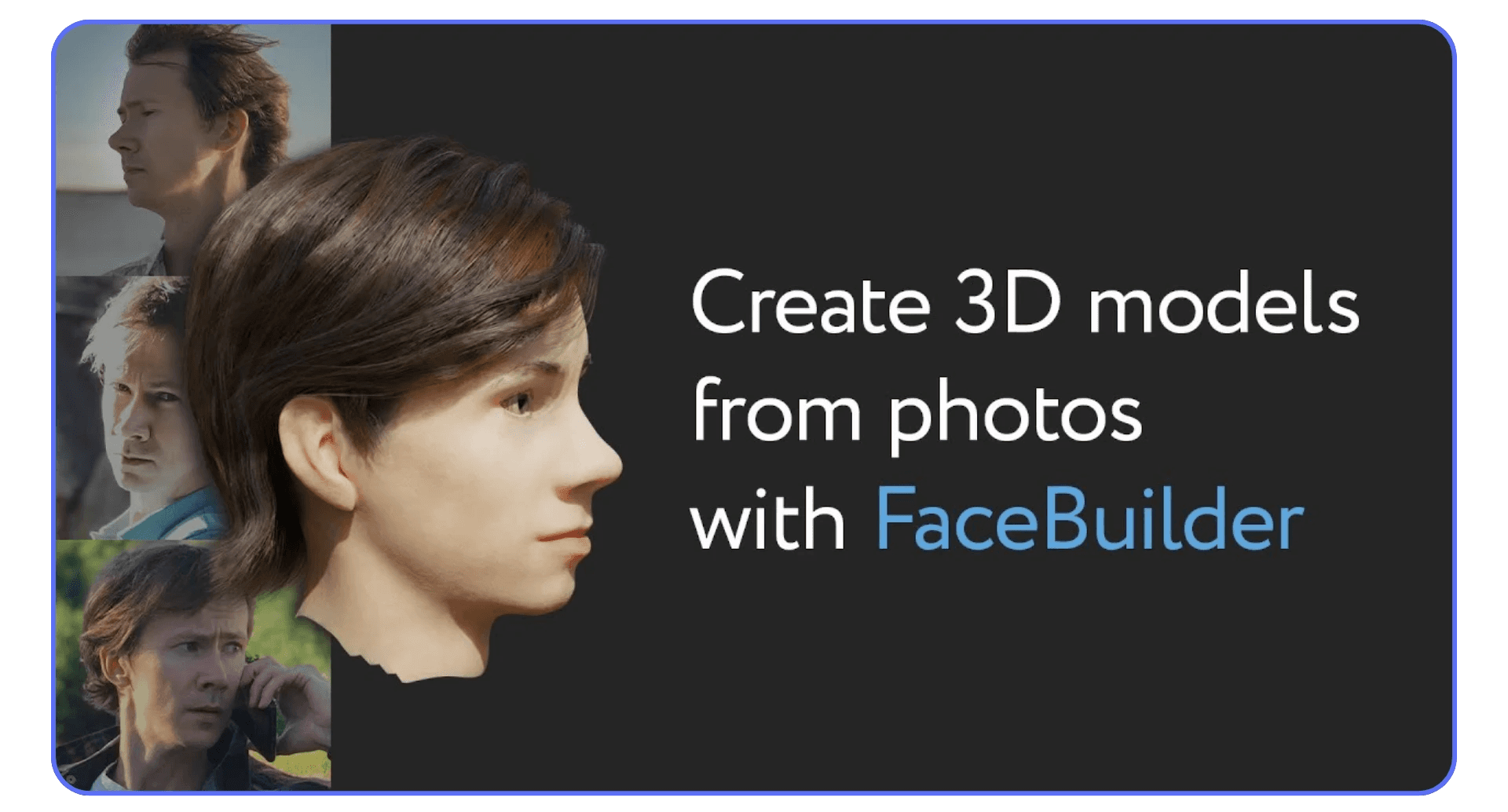
2026 Release Highlights: FaceBuilder now offers native support for Blender 4.4 Beta, ensuring compatibility with the latest geometry and node-based animation updates. A new Start Frame Selector allows for dynamic control of Clip and Sequence Mask inputs during tracking sessions, improving motion capture alignment. Additionally, a Wireframe Export Render mode was added to assist with topology validation and viewport performance profiling.
Avaturn
Avaturn is a powerful tool that allows users to create highly realistic 3D avatars from a simple selfie. Its AI-driven technology generates lifelike avatars that can be customized extensively, with options for different body types, hairstyles, clothes, and accessories. For Blender users, Avaturn offers seamless export options, making it easy to bring these avatars into your 3D projects.
One of the key strengths of Avaturn is its ease of use. Even with minimal technical knowledge, users can create detailed avatars that are ready for animation, complete with standard humanoid body rigs and ARKit blendshapes. This makes Avaturn especially appealing to game developers, content creators, and anyone wanting to integrate personalized avatars quickly.
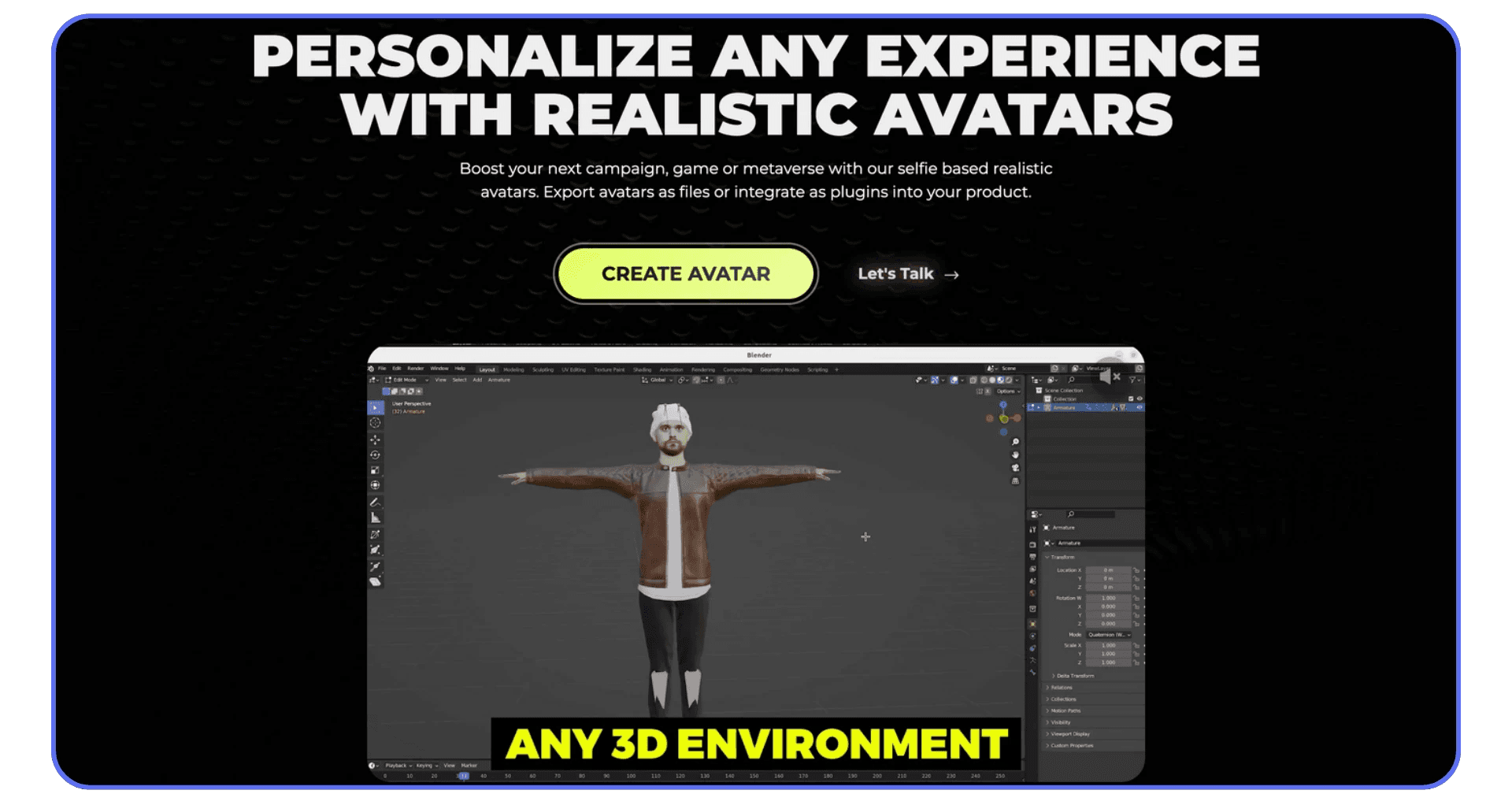
The unique selling point of Avaturn is its ability to maintain the user's true identity in avatar form, which can be crucial for applications in virtual reality, gaming, and social media. The tool’s integration capabilities also extend beyond Blender, supporting other 3D environments like Unity and Unreal Engine, making it a versatile addition to any 3D artist’s toolkit.
Create 3D Models from Text Prompts
Imagine turning your ideas into fully-formed 3D models just by typing a description. AI-powered text-to-3D generators make this possible by interpreting your words and instantly crafting detailed models that you can refine and use right in Blender. This groundbreaking approach speeds up prototyping and sparks creativity, giving artists and designers a powerful shortcut to bring imaginative concepts to life without wrestling with complex modeling techniques.
Shap-E
Shap-E is an innovative AI-powered tool that allows users to generate 3D models from text prompts within Blender. It’s one of the most effective Blender AI generators currently available for creators who want to rapidly prototype visual ideas from language input. Its standout feature is the ability to create complex and imaginative 3D assets simply by typing a description, making it an excellent choice for artists looking to rapidly prototype or explore creative ideas. The tool also supports batch creation, enabling users to generate entire asset packs in minutes, which is particularly useful for game developers or designers needing a large volume of models quickly.
One of Shap-E’s key strengths in Blender is its flexibility. Users can fine-tune the generated models using adjustable parameters, ensuring the output aligns closely with their vision. Additionally, the tool automatically applies materials to the generated models, streamlining the workflow further. This ease of use, combined with its ability to produce unique and varied results, makes Shap-E a valuable addition to any Blender user’s toolkit, especially those who want to push the boundaries of creativity without the constraints of traditional modeling techniques.
As of its 2026 revision, Shap-E introduces enhanced latent space conditioning for more accurate text-to-mesh generation. Users can now fine-tune parameters such as surface complexity, bounding box scale, and topology density prior to generation. Material nodes are auto-populated in Blender using principled BSDF shaders based on semantic interpretation of prompts.
3D Model Generator
The 3D Model Generator is a versatile Blender addon that enables users to create 3D models from text prompts or images. Its key feature is the ability to generate models quickly, usually within 10-15 seconds, which are then available as starting meshes for further refinement. The tool supports batch generation, making it particularly useful for projects that require multiple models in a short time.

One of the strengths of the 3D Model Generator in Blender is its efficiency. By allowing users to input simple text or image prompts, the tool automates much of the initial modeling work, freeing up time for artists to focus on more intricate details. The generated models are not textured, which provides a clean slate for users to apply their own artistic touch.
The unique selling point of the 3D Model Generator is its ability to quickly produce a wide variety of models, making it ideal for rapid prototyping or exploring new design ideas. This ease of use and flexibility makes it a valuable asset for both beginner and experienced Blender users who need to streamline their modeling workflow.
2026 Update: The generator engine now supports parallelized batch creation using multi-threaded prompt parsing. Models are instantiated as clean quad-based meshes, optimized for subdivision and Boolean operations inside Blender. A cache system has also been implemented to allow regeneration of previous prompts with consistent geometry.
Create 2D Images from Text Prompts
Bringing your ideas to life doesn’t have to stop at 3D models, with AI-driven image generators, you can create stunning 2D visuals straight from simple text prompts. These tools quickly produce high-resolution images that serve as concept art, textures, or unique assets you can integrate seamlessly into your Blender projects. Whether you’re brainstorming designs or adding intricate details, AI-generated images unlock a fast, creative way to visualize your vision.
Image Generator
The Image Generator addon for Blender leverages AI to create high-resolution images from text prompts. It’s powered by Playground V2.5, offering users an intuitive way to generate detailed images directly within Blender. This tool is particularly useful for artists and designers looking to quickly visualize concepts or create unique textures without needing advanced graphic design skills.
One of its main strengths in Blender is its seamless integration, allowing for immediate use within your workflow. The addon supports the generation of images in 1536 x 1536 resolution, making it suitable for high-quality renderings. Additionally, the recent updates have introduced features like negative prompts and enhanced image generation models, providing more control and flexibility over the output.

The unique selling point of the Image Generator is its ability to transform simple text descriptions into visually compelling images, making it a powerful tool for creative exploration and rapid prototyping. Whether you're working on game assets, digital art, or visual effects, this addon can significantly speed up your creative process.
If your workflow spans both 3D and 2D, tools like the Image Generator are a perfect bridge, and they complement workflows like 2D animation in Blender beautifully.
2026 Release: Now leveraging Playground V2.5+, the addon supports CLIP-guided latent diffusion with prompt weighting, enabling advanced use of positive and negative prompts. Output resolution has been increased to support up to 2048×2048px generation for texture workflows. Image outputs are now automatically mapped to Blender’s UV Editor via new node group presets.
Create 3D Models from 2D Images
Turning flat images into detailed 3D models is now a breeze with AI-powered tools that analyze and transform 2D visuals into fully textured, manipulable 3D assets. Perfect for artists who want to bring photos or sketches to life, these tools simplify the modeling process by automating complex geometry creation directly within Blender. Whether for character design, environment modeling, or architectural visualization, converting 2D images into 3D opens up exciting new creative possibilities.
AutoDepth AI
AutoDepth AI is a powerful Blender addon that automates the creation of accurate depth maps from images, transforming 2D visuals into 3D assets. This tool is especially useful for creating detailed terrains, architectural visualizations, and other complex scenes where depth and texture are critical.
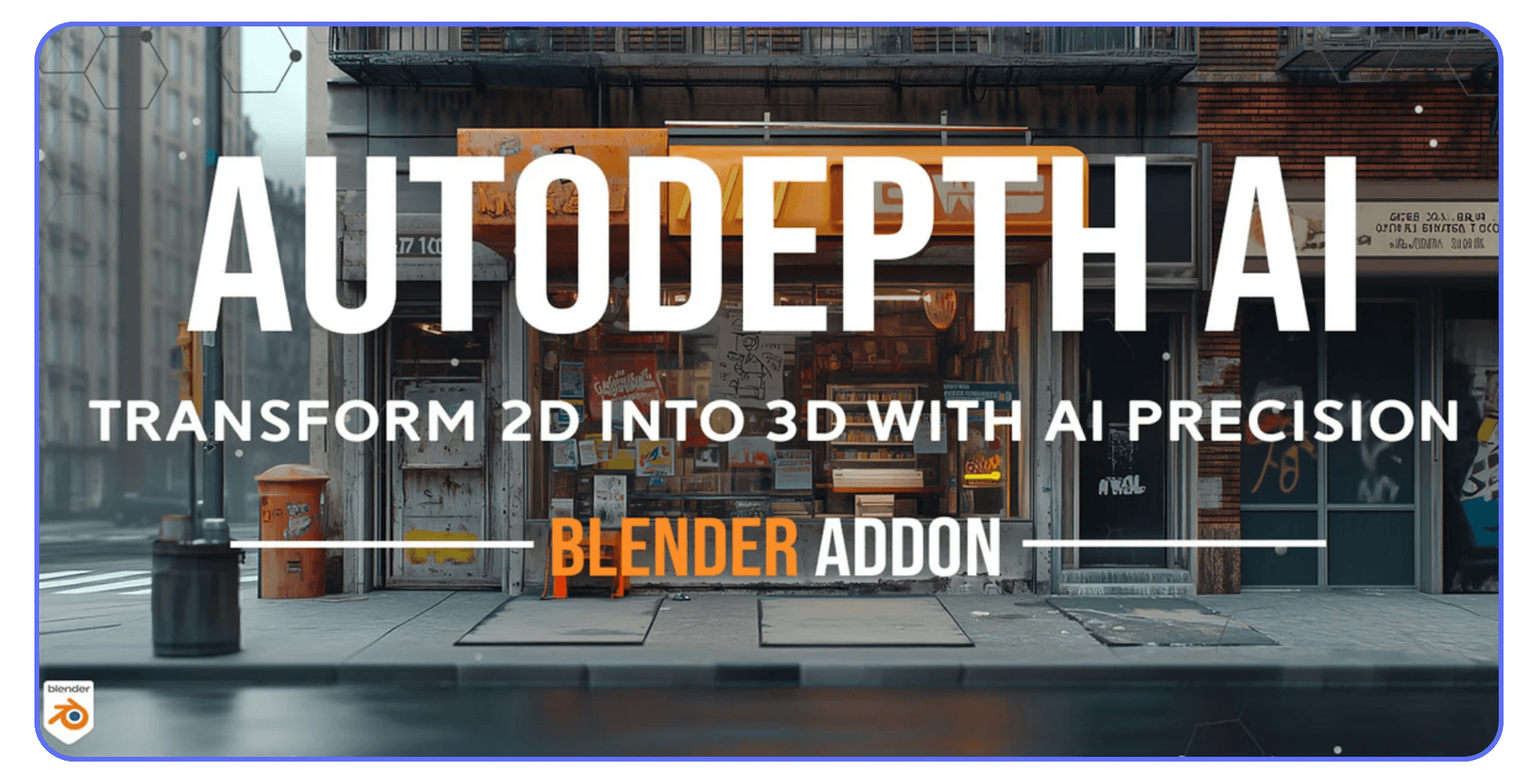
One of its key strengths in Blender is the seamless application of displacement mapping, allowing users to add realistic depth to their models without manual adjustments. The user-friendly interface makes it accessible to both professionals and hobbyists, integrating smoothly into existing workflows.
AutoDepth AI’s standout feature is its ability to generate 3D models directly from depth maps, offering a more dynamic and flexible approach to creation. This functionality is particularly valuable for artists looking to add intricate detail to their projects quickly and efficiently.
2026 Enhancements: AutoDepth now integrates with Blender’s displacement and bump mapping nodes, enabling high-fidelity geometry from grayscale or stereo-derived depth maps. The new algorithm uses multi-pass erosion/dilation filters for cleaner edge geometry, and supports displacement baking to reduce viewport lag during sculpting or rendering.
Pic To 3D Mesh
Pic To 3D Mesh is a Blender addon that transforms 2D images into detailed 3D models, providing a seamless way to bring photographs or illustrations to life in three dimensions. Powered by AI, this tool excels at generating and refining intricate 3D meshes directly from images with just a few clicks. It integrates smoothly with Blender, allowing for easy manipulation and customization of the generated models.
One of its main strengths is its ability to quickly convert flat images into complex 3D assets, making it ideal for artists and designers looking to enhance their projects with realistic details. The user-friendly interface and straightforward functionality mean that even those with limited experience in 3D modeling can achieve impressive results. Pic To 3D Mesh’s unique selling point is its efficiency and precision in generating 3D models from images, making it an essential tool for anyone looking to streamline their creative workflow in Blender.
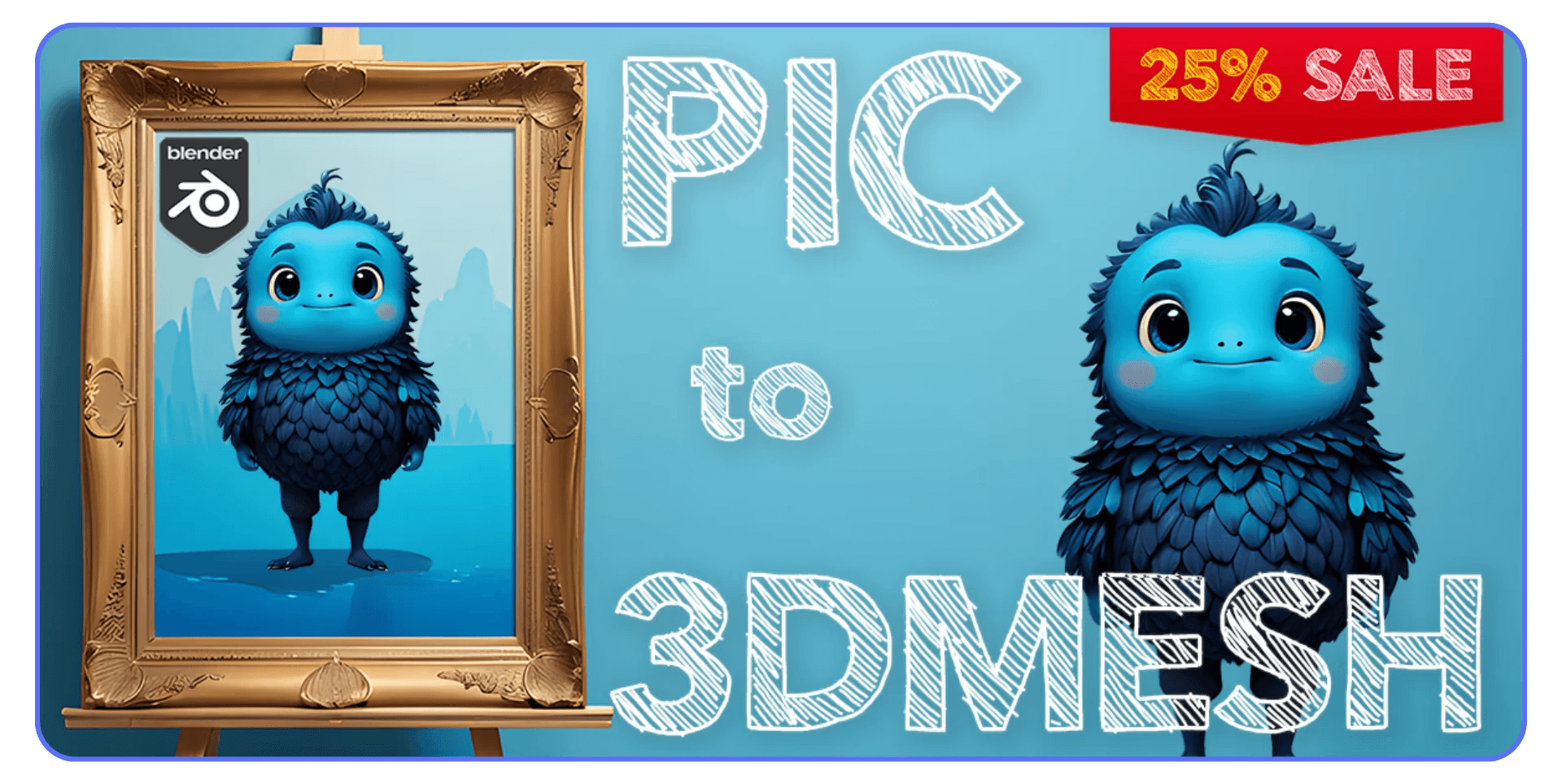
2026 Technical Update: Pic To 3D Mesh now utilizes an improved monocular depth estimation pipeline based on MiDaS v3.1 for enhanced edge fidelity and geometry recovery from low-contrast regions. The addon supports auto-retopology via Blender’s Remesh modifier and exports watertight meshes with optional decimation. Integration with the Asset Browser has been expanded for drag-and-drop asset management.
PixelModeller AI
PixelModeller AI integrates directly with Blender, enabling users to create detailed 3D models interactively by painting in the 2D editor. Models generated by PixelModeller are watertight, UV-mapped, and equipped with vertex colors, ready for rendering or further refinement. This tool is particularly well-suited for artists seeking an innovative and efficient way to create assets within Blender.
2026 Enhancements: PixelModeller AI has upgraded its voxel-to-mesh conversion algorithm to support adaptive meshing, which reduces polygon count while preserving sculptable surface detail. Models now include embedded vertex color data and baked ambient occlusion maps. Full compatibility with Blender’s UV/Image Editor allows immediate texture painting and procedural shading setup post-generation.
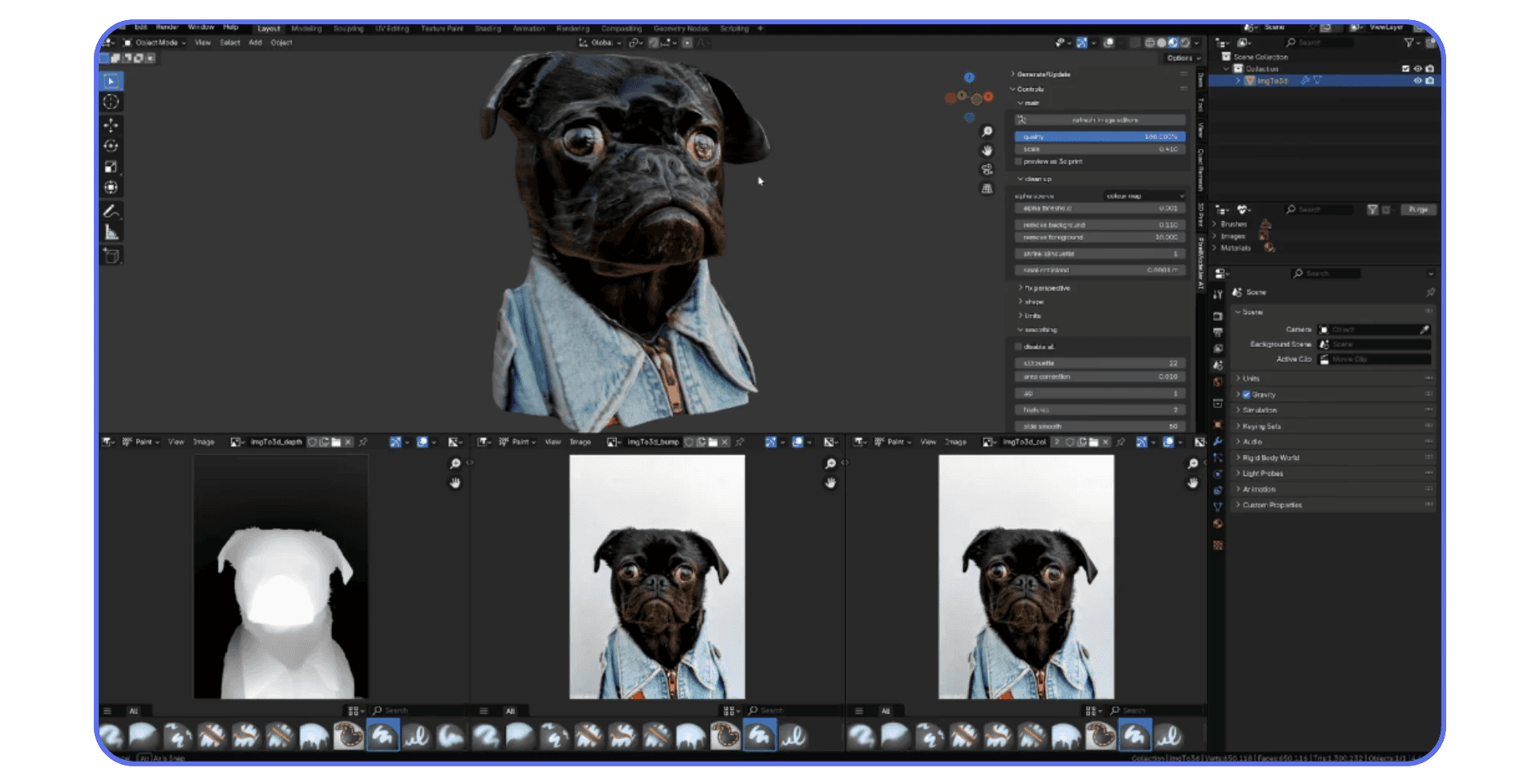
Blender AI Library Pro
Blender AI Library Pro is an advanced addon designed to bring AI-driven capabilities into Blender. It allows for the generation of PBR materials, procedural textures, and HDRIs from text descriptions or imported images. Its integration into Blender makes it a valuable asset for artists and designers aiming to simplify asset creation while maintaining high-quality results.
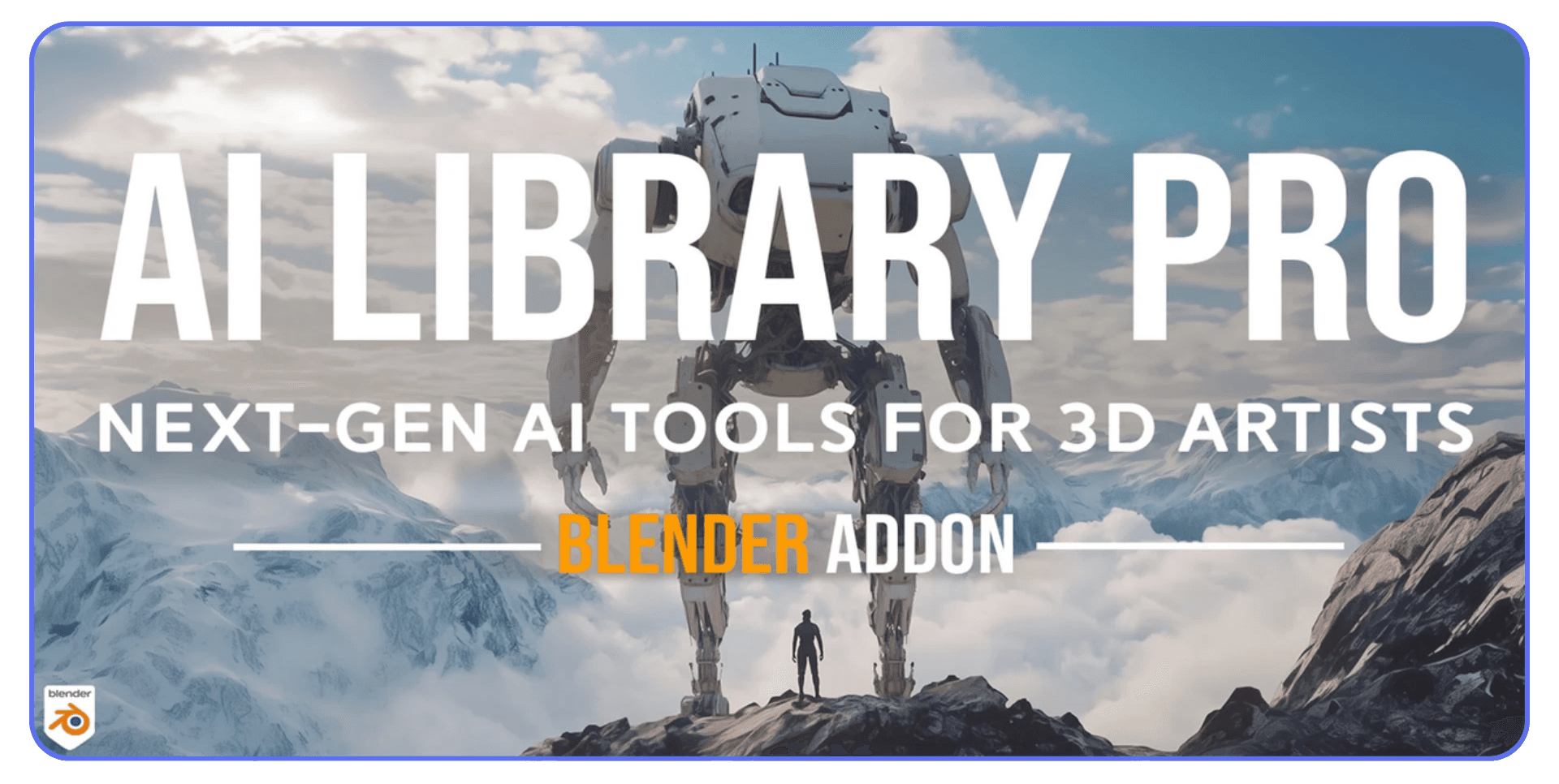
2026 Update: The latest version of Blender AI Library Pro introduces dynamic material generation from both natural language and image prompts using GPT-integrated shader scripting. The addon now supports real-time PBR node tree construction and automatic HDRI lighting environment matching. Assets are stored in a custom .baip format and registered with Blender’s internal asset catalog system.
DeepBlender
DeepBlender is a machine learning-powered addon tailored for Blender, offering tools for procedural modeling, auto-rigging characters, and generating animations. As a full-featured Blender AI plugin, DeepBlender integrates directly with procedural workflows and supports AI-driven animation logic for faster scene development. This addon enhances creative possibilities by incorporating advanced AI functionalities directly within the Blender interface. DeepBlender is especially beneficial for users exploring AI-driven solutions to improve their modeling and animation workflows.
2026 Update Highlights: DeepBlender now includes an auto-rigging framework based on OpenPose fusion with inverse kinematics support, streamlining humanoid animation pipelines. The procedural modeling module has added support for L-Systems and rule-based generation directly within Blender’s Geometry Nodes editor. New motion retargeting features allow ML-generated animation clips to be mapped onto custom rigs with automatic bone constraint resolution.
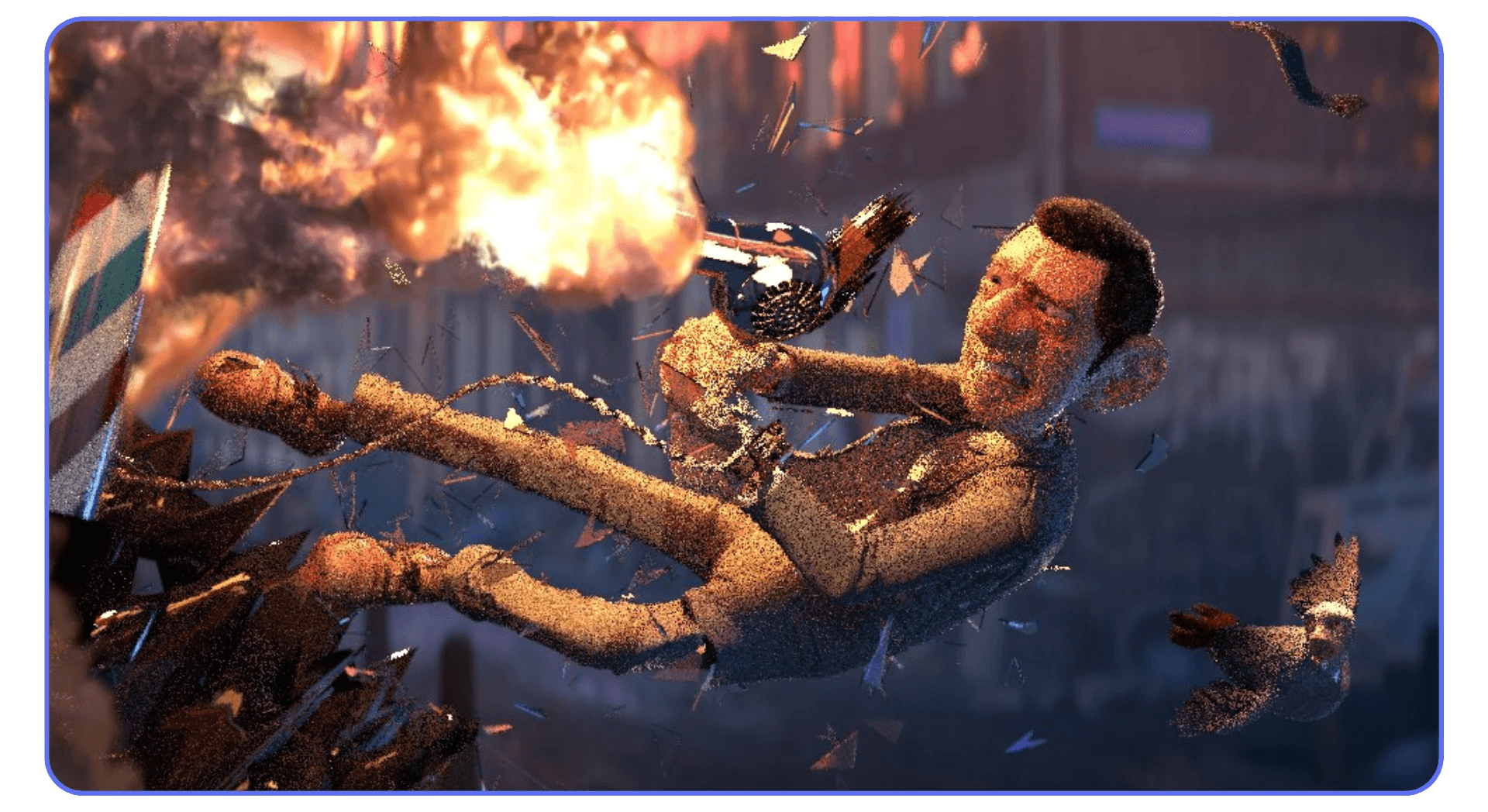
These tools offer Blender-specific solutions, making the software even more powerful for 3D modeling, animation, and design. With these integrations, artists can push the boundaries of creativity and efficiency in their projects.
Each of these tools brings something unique to the table, enhancing Blender’s already robust capabilities. Whether you’re looking to speed up your workflow, experiment with new creative ideas, or simplify complex tasks, these AI tools offer practical solutions that can significantly improve your 3D modeling experience.
Integration Tips
Integrating AI tools into your Blender workflow can significantly enhance productivity and creativity. Here are some tips on how to do it effectively:
Start Small: Begin by incorporating one tool at a time. For example, use FaceBuilder for character design before expanding to tools like Shap-E for text-to-model generation. This helps you master each tool’s functionality without overwhelming your workflow.
Combine Tools: Use tools in tandem for complex projects. Combining a Blender AI plugin like FaceBuilder with a Blender AI generator such as Shap-E can give you both facial detail and scene context within a unified workflow. For instance, generate base models with Meshy AI and add details with Pic To 3D Mesh. This approach leverages the strengths of each tool, resulting in more refined models.
Customize Your Workflow: Tailor the tools to suit your needs. For example, use AutoDepth AI to add realistic depth to models created with Avaturn. This allows for greater creative control and more polished results.
Save Time with Automation: Use batch processing features in tools like 3D Model Generator to quickly generate multiple assets. This is especially useful for game development or large-scale projects where time efficiency is crucial.
Experiment and Iterate: Don’t be afraid to experiment with different settings and combinations. AI tools often produce unexpected results that can spark new ideas or lead to creative breakthroughs.
And if you're ready to take your creative process even further, combining AI tools with a few pro-level Blender tips and tricks can make a big difference in polish and speed.
By integrating these tools thoughtfully into your Blender workflow, you can maximize both efficiency and creative potential, allowing you to focus more on the artistic aspects of your projects.
Workflow Enhancements
AI tools dramatically accelerate the design process in Blender by automating repetitive tasks and enabling rapid prototyping. For example, Shap-E allows designers to quickly generate 3D models from text prompts, saving hours that would otherwise be spent on manual modeling. Pic To 3D Mesh excels when transforming 2D reference images into detailed 3D models, which is particularly useful in architectural visualization or character design, where precision is crucial.
In game development, Meshy AI shines by quickly creating and texturing multiple assets, allowing developers to focus more on gameplay and less on asset creation. These tools enable artists to iterate faster, experiment with more ideas, and ultimately deliver higher-quality work in less time. By reducing the technical burden, AI tools let users spend more time on creativity and innovation.
Pairing AI tools with essential Blender shortcuts can further accelerate your workflow, letting you jump between modeling and automation without breaking creative momentum.
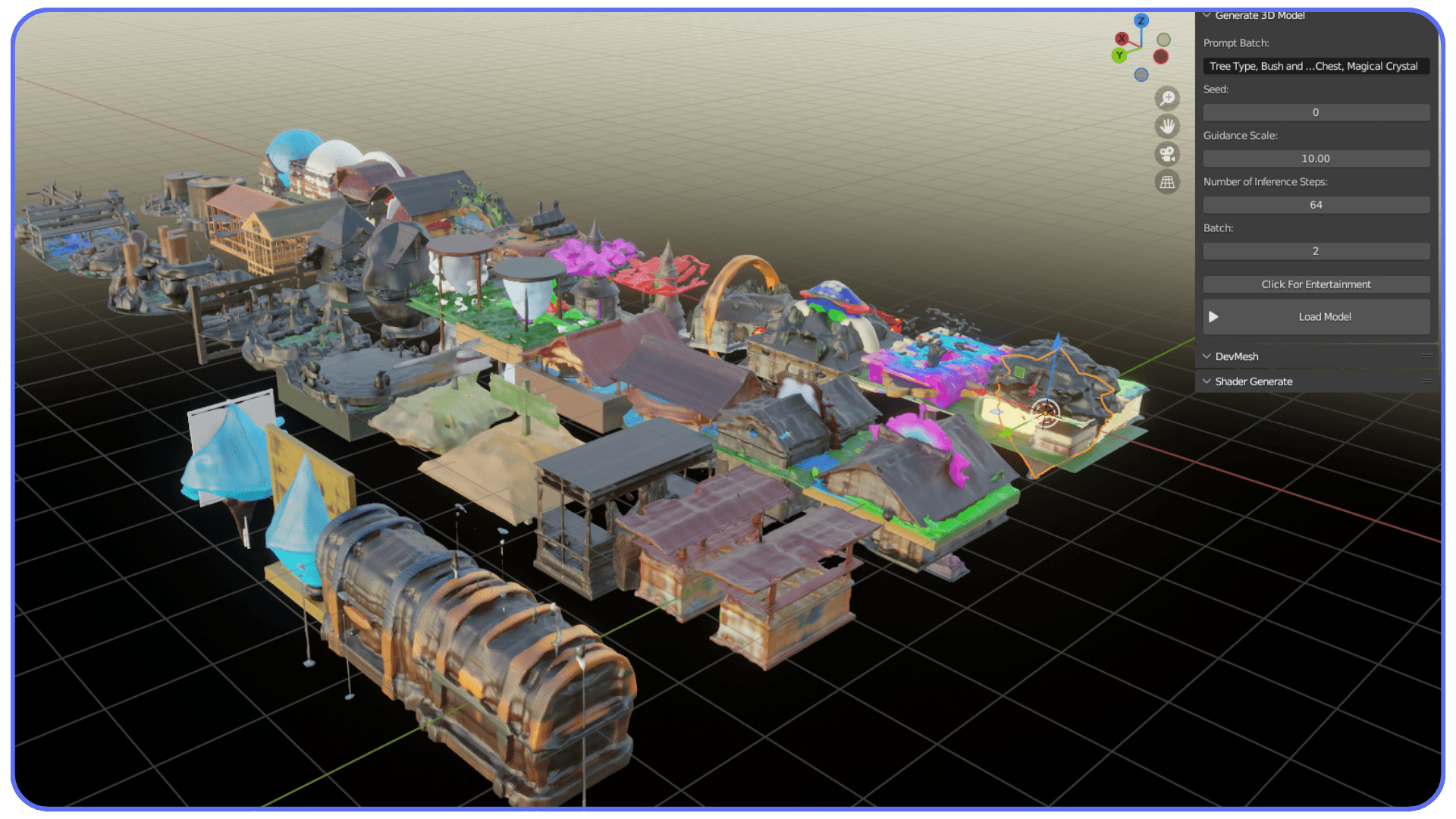
Limitations, Best Practices, and What AI Can’t Replace
AI tools in Blender are incredibly powerful, but they work best when used with clear expectations. Understanding their limitations will help you avoid frustration and get better results faster.
One important thing to keep in mind is that AI-generated models are usually starting points, not final assets. While tools like text-to-3D generators and image-based mesh creators can produce impressive geometry, the output often needs cleanup. Topology may require refinement, edge flow may not be animation-ready, and scale or proportions can sometimes be inconsistent. Knowing basic Blender modeling and sculpting fundamentals still makes a huge difference.
Prompt quality also matters more than many users expect. Vague text prompts tend to produce generic or unpredictable results, while specific descriptions yield far more usable models. Including details such as style, material type, symmetry, and intended use can dramatically improve outcomes. Treat prompts as creative direction rather than simple commands.
Another limitation is artistic consistency. AI tools are excellent for ideation and speed, but maintaining a cohesive visual style across an entire project still requires human judgment. This is especially true for game assets, films, or branded content where consistency is critical. Many artists use AI for blockouts, base meshes, or concept exploration, then manually refine assets to match their style guide.
Performance is also a consideration. Some AI addons rely heavily on GPU resources or external cloud processing, which can introduce latency or usage limits. Planning when to generate assets versus when to refine them locally helps keep workflows smooth, especially on larger projects.
The best results come from a hybrid approach. Use AI to eliminate repetitive or time-consuming steps, then rely on Blender’s traditional tools for polishing, optimization, and creative control. When AI is treated as a collaborator rather than a replacement, it becomes one of the most powerful additions to a modern Blender workflow.
Faster Blender AI Renders
As AI continues to simplify 3D modeling in Blender, helping you generate avatars, assets, environments, and even full scenes with just a prompt, the possibilities for creativity are expanding faster than ever. But behind every smooth workflow is the need for serious processing power. AI-driven tools can be demanding, especially when you're batch-generating models, applying complex PBR materials, or rendering high-resolution textures and animations.
That’s where Vagon comes in. With cloud computers powered by 48 cores, 4 x 24GB RTX-enabled GPUs, and 192GB of RAM, Vagon lets you experience the true potential of Blender AI workflows without worrying about performance limitations or hardware bottlenecks. You can run advanced AI plugins, experiment freely, and work on intensive projects right from your browser, all while keeping your local machine light and responsive.
Whether you're a solo creator prototyping ideas or part of a production team building large-scale projects, Vagon gives you the flexibility and performance to move faster, iterate more, and stay in your creative flow.
Try Vagon today and see how cloud power can elevate your Blender AI experience from experimentation to production—no setup, no slowdown, just pure creative momentum.
Conclusion
AI has revolutionized Blender 3D modeling by simplifying complex tasks and opening new creative possibilities. Tools like FaceBuilder, Shap-E, and Meshy AI allow artists to work faster, experiment more, and achieve high-quality results with less effort. These tools remove many technical barriers, enabling both beginners and professionals to focus more on creativity.
From indie creators to full production studios, AI tools are fueling the next wave of 3D content, many of which follow the path of stunning movies made entirely with Blender.
I encourage you to explore and experiment with these AI tools in your projects. Embracing AI can transform your workflow and elevate your 3D modeling skills to new heights.
Frequently Asked Questions:
1. What are the benefits of using AI tools in Blender for 3D modeling?
AI tools in Blender streamline the 3D modeling process by automating repetitive tasks, generating models from text or images, and enabling quick prototyping. They simplify complex modeling tasks, save time, and allow artists to focus more on creativity, making the software accessible to both beginners and experienced users.
2. Which AI tool is best for beginners in Blender 3D?
For beginners, tools like the 3D Model Generator and Shap-E are great starting points. These tools allow users to generate 3D models from simple text prompts, which reduces the need for advanced modeling skills. Additionally, their user-friendly interfaces make it easy for newcomers to explore 3D creation without a steep learning curve.
3. Can AI tools in Blender create realistic 3D avatars from photos?
Yes, AI tools such as Avaturn and KeenTools FaceBuilder for Blender can create realistic 3D avatars from photos. These tools use advanced facial recognition and modeling algorithms to transform 2D images into lifelike 3D models, ideal for game development, animation, and VR applications.
4. How do text-to-3D model generators work in Blender?
Text-to-3D model generators like Shap-E and the 3D Model Generator use AI to interpret text prompts and generate corresponding 3D models. Users simply describe the desired object, and the tool creates a basic 3D mesh that can be refined further in Blender. This approach is highly efficient for rapid prototyping and exploring creative ideas.
5. Are AI tools compatible with different Blender versions?
Most AI tools for Blender are compatible with recent versions of the software, though compatibility may vary. It’s generally recommended to check each tool’s documentation for specific version requirements to ensure smooth integration and performance.
6. What is the best way to integrate multiple AI tools in a Blender workflow?
Integrating multiple AI tools in Blender is best approached by starting with one tool at a time. Once you’re comfortable, you can combine tools, for instance, using Meshy AI for base models and Pic To 3D Mesh for adding intricate details. Experimenting with tool combinations lets you leverage their strengths and customize your workflow for optimal results.
7. What is a Blender AI plugin?
A Blender AI plugin is a third-party addon that brings artificial intelligence functionality into Blender, for example, for auto-rigging, text-to-model generation, or facial reconstruction.
8. How do I use an AI Blender model generator?
You input a text prompt or reference image into the generator (like Meshy AI), and it outputs a basic 3D model you can further edit or render in Blender.
The world of 3D modeling has been transformed by the integration of artificial intelligence (AI). This shift is particularly evident in Blender 3D, a popular open-source software that has embraced AI to enhance its capabilities. AI tools in Blender are becoming essential for artists looking to accelerate their 3D workflows. AI tools have revolutionized the way models are generated, making the process faster, more efficient, and accessible to a broader audience.
Blender is becoming increasingly versatile and accessible, whether you're working from a high-performance PC or even modeling on an iPad, there are now more ways than ever to integrate it into your creative process.
For those who may not have the time or desire to master complex modeling techniques, AI tools offer a powerful alternative. They allow users to create high-quality models without the steep learning curve, significantly reducing the time spent on manual tasks. Whether you're a beginner or a seasoned professional, these tools can streamline your workflow, enabling you to focus on creativity rather than technical details.

Overview of the Top AI Tools
Blender 3D’s versatility is greatly enhanced by several AI tools that integrate seamlessly into its ecosystem, making the modeling process more efficient and accessible. The KeenTools Blender Pack, for example, offers powerful facial tracking and 3D head model generation, which is invaluable for character designers and animators. The Blender Text to 3D AI Generator allows users to transform text prompts into 3D models, eliminating the need for complex manual modeling. Pic To 3D Mesh converts 2D images into detailed 3D meshes, simplifying the creation of complex models from references. Meanwhile, Meshy AI excels in procedural generation, enabling the creation of intricate designs with minimal input. These tools not only streamline workflows but also open up new creative possibilities for both novice and expert users alike.
List of AI Tools
When it comes to AI tools optimized for Blender 3D, each offers distinct features that cater to different aspects of the modeling process. Here’s a closer look at some of the top contenders:
Meshy AI
Meshy AI is a cutting-edge tool designed to simplify the creation of 3D models and textures using AI. As an advanced AI Blender model generator, Meshy AI allows users to quickly generate assets from text or image prompts and export them directly to Blender with minimal manual setup. It offers a range of features, including the ability to generate 3D models from text prompts and images, and automatically apply PBR (Physically Based Rendering) maps for realistic results. This tool is particularly powerful in Blender, where it integrates seamlessly, allowing users to export models in various formats such as FBX, OBJ, and BLEND.
One of Meshy AI’s greatest strengths is its speed and user-friendliness. The tool is designed to produce high-quality 3D assets quickly, making it ideal for both professionals and hobbyists who need to streamline their workflow. With its simple interface, even users with limited experience in 3D modeling can achieve impressive results. The ability to texture models without the need for UV mapping is another standout feature, saving users significant time and effort.
Meshy AI's unique selling point is its versatility and efficiency. Whether you're looking to create game assets, digital art, or architectural visualizations, Meshy AI provides a fast and effective way to bring your ideas to life. The tool's ability to generate and texture models with minimal input makes it an essential addition to any Blender user’s toolkit.

2026 Technical Update: Meshy AI’s latest release introduces GPU-accelerated model generation pipelines with improved inference times across NVIDIA RTX and Apple Silicon hardware. The tool now supports fully automated PBR material generation with real-time preview, eliminating the need for manual UV unwrapping. Export formats include updated support for GLB in addition to FBX, OBJ, and native BLEND, streamlining integration with Blender’s Asset Browser and Geometry Nodes workflows.
Create 3D Avatars from 2D Faces
Creating lifelike 3D avatars from simple 2D photos used to be a complex task, but with the latest AI-powered tools, it’s now easier and faster than ever. These innovative solutions take your selfies or reference images and transform them into detailed, customizable 3D models ready for animation or integration into Blender projects. Whether you’re crafting characters for games, VR, or digital storytelling, AI-driven avatar creators unlock new levels of realism and personalization without the technical hassle.
KeenTools FaceBuilder for Blender
KeenTools FaceBuilder for Blender is an advanced tool that simplifies the creation of highly accurate 3D head models directly within Blender. By using just a few reference photographs, FaceBuilder can generate precise 3D facial structures, making it a valuable asset for character designers and animators. The tool’s integration with Blender is seamless, providing a user-friendly experience that doesn’t require extensive 3D modeling expertise.
One of FaceBuilder’s key strengths is its ability to deliver precise facial tracking, which is essential for realistic character animation. It also supports easy adjustments and refinements, allowing artists to quickly achieve the desired look and expression. This tool stands out for its accuracy and efficiency, significantly reducing the time needed for manual sculpting while maintaining high-quality results. This makes it an ideal choice for both professionals looking to streamline their workflow and beginners who need a straightforward solution to create complex facial models.

2026 Release Highlights: FaceBuilder now offers native support for Blender 4.4 Beta, ensuring compatibility with the latest geometry and node-based animation updates. A new Start Frame Selector allows for dynamic control of Clip and Sequence Mask inputs during tracking sessions, improving motion capture alignment. Additionally, a Wireframe Export Render mode was added to assist with topology validation and viewport performance profiling.
Avaturn
Avaturn is a powerful tool that allows users to create highly realistic 3D avatars from a simple selfie. Its AI-driven technology generates lifelike avatars that can be customized extensively, with options for different body types, hairstyles, clothes, and accessories. For Blender users, Avaturn offers seamless export options, making it easy to bring these avatars into your 3D projects.
One of the key strengths of Avaturn is its ease of use. Even with minimal technical knowledge, users can create detailed avatars that are ready for animation, complete with standard humanoid body rigs and ARKit blendshapes. This makes Avaturn especially appealing to game developers, content creators, and anyone wanting to integrate personalized avatars quickly.

The unique selling point of Avaturn is its ability to maintain the user's true identity in avatar form, which can be crucial for applications in virtual reality, gaming, and social media. The tool’s integration capabilities also extend beyond Blender, supporting other 3D environments like Unity and Unreal Engine, making it a versatile addition to any 3D artist’s toolkit.
Create 3D Models from Text Prompts
Imagine turning your ideas into fully-formed 3D models just by typing a description. AI-powered text-to-3D generators make this possible by interpreting your words and instantly crafting detailed models that you can refine and use right in Blender. This groundbreaking approach speeds up prototyping and sparks creativity, giving artists and designers a powerful shortcut to bring imaginative concepts to life without wrestling with complex modeling techniques.
Shap-E
Shap-E is an innovative AI-powered tool that allows users to generate 3D models from text prompts within Blender. It’s one of the most effective Blender AI generators currently available for creators who want to rapidly prototype visual ideas from language input. Its standout feature is the ability to create complex and imaginative 3D assets simply by typing a description, making it an excellent choice for artists looking to rapidly prototype or explore creative ideas. The tool also supports batch creation, enabling users to generate entire asset packs in minutes, which is particularly useful for game developers or designers needing a large volume of models quickly.
One of Shap-E’s key strengths in Blender is its flexibility. Users can fine-tune the generated models using adjustable parameters, ensuring the output aligns closely with their vision. Additionally, the tool automatically applies materials to the generated models, streamlining the workflow further. This ease of use, combined with its ability to produce unique and varied results, makes Shap-E a valuable addition to any Blender user’s toolkit, especially those who want to push the boundaries of creativity without the constraints of traditional modeling techniques.
As of its 2026 revision, Shap-E introduces enhanced latent space conditioning for more accurate text-to-mesh generation. Users can now fine-tune parameters such as surface complexity, bounding box scale, and topology density prior to generation. Material nodes are auto-populated in Blender using principled BSDF shaders based on semantic interpretation of prompts.
3D Model Generator
The 3D Model Generator is a versatile Blender addon that enables users to create 3D models from text prompts or images. Its key feature is the ability to generate models quickly, usually within 10-15 seconds, which are then available as starting meshes for further refinement. The tool supports batch generation, making it particularly useful for projects that require multiple models in a short time.

One of the strengths of the 3D Model Generator in Blender is its efficiency. By allowing users to input simple text or image prompts, the tool automates much of the initial modeling work, freeing up time for artists to focus on more intricate details. The generated models are not textured, which provides a clean slate for users to apply their own artistic touch.
The unique selling point of the 3D Model Generator is its ability to quickly produce a wide variety of models, making it ideal for rapid prototyping or exploring new design ideas. This ease of use and flexibility makes it a valuable asset for both beginner and experienced Blender users who need to streamline their modeling workflow.
2026 Update: The generator engine now supports parallelized batch creation using multi-threaded prompt parsing. Models are instantiated as clean quad-based meshes, optimized for subdivision and Boolean operations inside Blender. A cache system has also been implemented to allow regeneration of previous prompts with consistent geometry.
Create 2D Images from Text Prompts
Bringing your ideas to life doesn’t have to stop at 3D models, with AI-driven image generators, you can create stunning 2D visuals straight from simple text prompts. These tools quickly produce high-resolution images that serve as concept art, textures, or unique assets you can integrate seamlessly into your Blender projects. Whether you’re brainstorming designs or adding intricate details, AI-generated images unlock a fast, creative way to visualize your vision.
Image Generator
The Image Generator addon for Blender leverages AI to create high-resolution images from text prompts. It’s powered by Playground V2.5, offering users an intuitive way to generate detailed images directly within Blender. This tool is particularly useful for artists and designers looking to quickly visualize concepts or create unique textures without needing advanced graphic design skills.
One of its main strengths in Blender is its seamless integration, allowing for immediate use within your workflow. The addon supports the generation of images in 1536 x 1536 resolution, making it suitable for high-quality renderings. Additionally, the recent updates have introduced features like negative prompts and enhanced image generation models, providing more control and flexibility over the output.

The unique selling point of the Image Generator is its ability to transform simple text descriptions into visually compelling images, making it a powerful tool for creative exploration and rapid prototyping. Whether you're working on game assets, digital art, or visual effects, this addon can significantly speed up your creative process.
If your workflow spans both 3D and 2D, tools like the Image Generator are a perfect bridge, and they complement workflows like 2D animation in Blender beautifully.
2026 Release: Now leveraging Playground V2.5+, the addon supports CLIP-guided latent diffusion with prompt weighting, enabling advanced use of positive and negative prompts. Output resolution has been increased to support up to 2048×2048px generation for texture workflows. Image outputs are now automatically mapped to Blender’s UV Editor via new node group presets.
Create 3D Models from 2D Images
Turning flat images into detailed 3D models is now a breeze with AI-powered tools that analyze and transform 2D visuals into fully textured, manipulable 3D assets. Perfect for artists who want to bring photos or sketches to life, these tools simplify the modeling process by automating complex geometry creation directly within Blender. Whether for character design, environment modeling, or architectural visualization, converting 2D images into 3D opens up exciting new creative possibilities.
AutoDepth AI
AutoDepth AI is a powerful Blender addon that automates the creation of accurate depth maps from images, transforming 2D visuals into 3D assets. This tool is especially useful for creating detailed terrains, architectural visualizations, and other complex scenes where depth and texture are critical.

One of its key strengths in Blender is the seamless application of displacement mapping, allowing users to add realistic depth to their models without manual adjustments. The user-friendly interface makes it accessible to both professionals and hobbyists, integrating smoothly into existing workflows.
AutoDepth AI’s standout feature is its ability to generate 3D models directly from depth maps, offering a more dynamic and flexible approach to creation. This functionality is particularly valuable for artists looking to add intricate detail to their projects quickly and efficiently.
2026 Enhancements: AutoDepth now integrates with Blender’s displacement and bump mapping nodes, enabling high-fidelity geometry from grayscale or stereo-derived depth maps. The new algorithm uses multi-pass erosion/dilation filters for cleaner edge geometry, and supports displacement baking to reduce viewport lag during sculpting or rendering.
Pic To 3D Mesh
Pic To 3D Mesh is a Blender addon that transforms 2D images into detailed 3D models, providing a seamless way to bring photographs or illustrations to life in three dimensions. Powered by AI, this tool excels at generating and refining intricate 3D meshes directly from images with just a few clicks. It integrates smoothly with Blender, allowing for easy manipulation and customization of the generated models.
One of its main strengths is its ability to quickly convert flat images into complex 3D assets, making it ideal for artists and designers looking to enhance their projects with realistic details. The user-friendly interface and straightforward functionality mean that even those with limited experience in 3D modeling can achieve impressive results. Pic To 3D Mesh’s unique selling point is its efficiency and precision in generating 3D models from images, making it an essential tool for anyone looking to streamline their creative workflow in Blender.

2026 Technical Update: Pic To 3D Mesh now utilizes an improved monocular depth estimation pipeline based on MiDaS v3.1 for enhanced edge fidelity and geometry recovery from low-contrast regions. The addon supports auto-retopology via Blender’s Remesh modifier and exports watertight meshes with optional decimation. Integration with the Asset Browser has been expanded for drag-and-drop asset management.
PixelModeller AI
PixelModeller AI integrates directly with Blender, enabling users to create detailed 3D models interactively by painting in the 2D editor. Models generated by PixelModeller are watertight, UV-mapped, and equipped with vertex colors, ready for rendering or further refinement. This tool is particularly well-suited for artists seeking an innovative and efficient way to create assets within Blender.
2026 Enhancements: PixelModeller AI has upgraded its voxel-to-mesh conversion algorithm to support adaptive meshing, which reduces polygon count while preserving sculptable surface detail. Models now include embedded vertex color data and baked ambient occlusion maps. Full compatibility with Blender’s UV/Image Editor allows immediate texture painting and procedural shading setup post-generation.

Blender AI Library Pro
Blender AI Library Pro is an advanced addon designed to bring AI-driven capabilities into Blender. It allows for the generation of PBR materials, procedural textures, and HDRIs from text descriptions or imported images. Its integration into Blender makes it a valuable asset for artists and designers aiming to simplify asset creation while maintaining high-quality results.

2026 Update: The latest version of Blender AI Library Pro introduces dynamic material generation from both natural language and image prompts using GPT-integrated shader scripting. The addon now supports real-time PBR node tree construction and automatic HDRI lighting environment matching. Assets are stored in a custom .baip format and registered with Blender’s internal asset catalog system.
DeepBlender
DeepBlender is a machine learning-powered addon tailored for Blender, offering tools for procedural modeling, auto-rigging characters, and generating animations. As a full-featured Blender AI plugin, DeepBlender integrates directly with procedural workflows and supports AI-driven animation logic for faster scene development. This addon enhances creative possibilities by incorporating advanced AI functionalities directly within the Blender interface. DeepBlender is especially beneficial for users exploring AI-driven solutions to improve their modeling and animation workflows.
2026 Update Highlights: DeepBlender now includes an auto-rigging framework based on OpenPose fusion with inverse kinematics support, streamlining humanoid animation pipelines. The procedural modeling module has added support for L-Systems and rule-based generation directly within Blender’s Geometry Nodes editor. New motion retargeting features allow ML-generated animation clips to be mapped onto custom rigs with automatic bone constraint resolution.

These tools offer Blender-specific solutions, making the software even more powerful for 3D modeling, animation, and design. With these integrations, artists can push the boundaries of creativity and efficiency in their projects.
Each of these tools brings something unique to the table, enhancing Blender’s already robust capabilities. Whether you’re looking to speed up your workflow, experiment with new creative ideas, or simplify complex tasks, these AI tools offer practical solutions that can significantly improve your 3D modeling experience.
Integration Tips
Integrating AI tools into your Blender workflow can significantly enhance productivity and creativity. Here are some tips on how to do it effectively:
Start Small: Begin by incorporating one tool at a time. For example, use FaceBuilder for character design before expanding to tools like Shap-E for text-to-model generation. This helps you master each tool’s functionality without overwhelming your workflow.
Combine Tools: Use tools in tandem for complex projects. Combining a Blender AI plugin like FaceBuilder with a Blender AI generator such as Shap-E can give you both facial detail and scene context within a unified workflow. For instance, generate base models with Meshy AI and add details with Pic To 3D Mesh. This approach leverages the strengths of each tool, resulting in more refined models.
Customize Your Workflow: Tailor the tools to suit your needs. For example, use AutoDepth AI to add realistic depth to models created with Avaturn. This allows for greater creative control and more polished results.
Save Time with Automation: Use batch processing features in tools like 3D Model Generator to quickly generate multiple assets. This is especially useful for game development or large-scale projects where time efficiency is crucial.
Experiment and Iterate: Don’t be afraid to experiment with different settings and combinations. AI tools often produce unexpected results that can spark new ideas or lead to creative breakthroughs.
And if you're ready to take your creative process even further, combining AI tools with a few pro-level Blender tips and tricks can make a big difference in polish and speed.
By integrating these tools thoughtfully into your Blender workflow, you can maximize both efficiency and creative potential, allowing you to focus more on the artistic aspects of your projects.
Workflow Enhancements
AI tools dramatically accelerate the design process in Blender by automating repetitive tasks and enabling rapid prototyping. For example, Shap-E allows designers to quickly generate 3D models from text prompts, saving hours that would otherwise be spent on manual modeling. Pic To 3D Mesh excels when transforming 2D reference images into detailed 3D models, which is particularly useful in architectural visualization or character design, where precision is crucial.
In game development, Meshy AI shines by quickly creating and texturing multiple assets, allowing developers to focus more on gameplay and less on asset creation. These tools enable artists to iterate faster, experiment with more ideas, and ultimately deliver higher-quality work in less time. By reducing the technical burden, AI tools let users spend more time on creativity and innovation.
Pairing AI tools with essential Blender shortcuts can further accelerate your workflow, letting you jump between modeling and automation without breaking creative momentum.

Limitations, Best Practices, and What AI Can’t Replace
AI tools in Blender are incredibly powerful, but they work best when used with clear expectations. Understanding their limitations will help you avoid frustration and get better results faster.
One important thing to keep in mind is that AI-generated models are usually starting points, not final assets. While tools like text-to-3D generators and image-based mesh creators can produce impressive geometry, the output often needs cleanup. Topology may require refinement, edge flow may not be animation-ready, and scale or proportions can sometimes be inconsistent. Knowing basic Blender modeling and sculpting fundamentals still makes a huge difference.
Prompt quality also matters more than many users expect. Vague text prompts tend to produce generic or unpredictable results, while specific descriptions yield far more usable models. Including details such as style, material type, symmetry, and intended use can dramatically improve outcomes. Treat prompts as creative direction rather than simple commands.
Another limitation is artistic consistency. AI tools are excellent for ideation and speed, but maintaining a cohesive visual style across an entire project still requires human judgment. This is especially true for game assets, films, or branded content where consistency is critical. Many artists use AI for blockouts, base meshes, or concept exploration, then manually refine assets to match their style guide.
Performance is also a consideration. Some AI addons rely heavily on GPU resources or external cloud processing, which can introduce latency or usage limits. Planning when to generate assets versus when to refine them locally helps keep workflows smooth, especially on larger projects.
The best results come from a hybrid approach. Use AI to eliminate repetitive or time-consuming steps, then rely on Blender’s traditional tools for polishing, optimization, and creative control. When AI is treated as a collaborator rather than a replacement, it becomes one of the most powerful additions to a modern Blender workflow.
Faster Blender AI Renders
As AI continues to simplify 3D modeling in Blender, helping you generate avatars, assets, environments, and even full scenes with just a prompt, the possibilities for creativity are expanding faster than ever. But behind every smooth workflow is the need for serious processing power. AI-driven tools can be demanding, especially when you're batch-generating models, applying complex PBR materials, or rendering high-resolution textures and animations.
That’s where Vagon comes in. With cloud computers powered by 48 cores, 4 x 24GB RTX-enabled GPUs, and 192GB of RAM, Vagon lets you experience the true potential of Blender AI workflows without worrying about performance limitations or hardware bottlenecks. You can run advanced AI plugins, experiment freely, and work on intensive projects right from your browser, all while keeping your local machine light and responsive.
Whether you're a solo creator prototyping ideas or part of a production team building large-scale projects, Vagon gives you the flexibility and performance to move faster, iterate more, and stay in your creative flow.
Try Vagon today and see how cloud power can elevate your Blender AI experience from experimentation to production—no setup, no slowdown, just pure creative momentum.
Conclusion
AI has revolutionized Blender 3D modeling by simplifying complex tasks and opening new creative possibilities. Tools like FaceBuilder, Shap-E, and Meshy AI allow artists to work faster, experiment more, and achieve high-quality results with less effort. These tools remove many technical barriers, enabling both beginners and professionals to focus more on creativity.
From indie creators to full production studios, AI tools are fueling the next wave of 3D content, many of which follow the path of stunning movies made entirely with Blender.
I encourage you to explore and experiment with these AI tools in your projects. Embracing AI can transform your workflow and elevate your 3D modeling skills to new heights.
Frequently Asked Questions:
1. What are the benefits of using AI tools in Blender for 3D modeling?
AI tools in Blender streamline the 3D modeling process by automating repetitive tasks, generating models from text or images, and enabling quick prototyping. They simplify complex modeling tasks, save time, and allow artists to focus more on creativity, making the software accessible to both beginners and experienced users.
2. Which AI tool is best for beginners in Blender 3D?
For beginners, tools like the 3D Model Generator and Shap-E are great starting points. These tools allow users to generate 3D models from simple text prompts, which reduces the need for advanced modeling skills. Additionally, their user-friendly interfaces make it easy for newcomers to explore 3D creation without a steep learning curve.
3. Can AI tools in Blender create realistic 3D avatars from photos?
Yes, AI tools such as Avaturn and KeenTools FaceBuilder for Blender can create realistic 3D avatars from photos. These tools use advanced facial recognition and modeling algorithms to transform 2D images into lifelike 3D models, ideal for game development, animation, and VR applications.
4. How do text-to-3D model generators work in Blender?
Text-to-3D model generators like Shap-E and the 3D Model Generator use AI to interpret text prompts and generate corresponding 3D models. Users simply describe the desired object, and the tool creates a basic 3D mesh that can be refined further in Blender. This approach is highly efficient for rapid prototyping and exploring creative ideas.
5. Are AI tools compatible with different Blender versions?
Most AI tools for Blender are compatible with recent versions of the software, though compatibility may vary. It’s generally recommended to check each tool’s documentation for specific version requirements to ensure smooth integration and performance.
6. What is the best way to integrate multiple AI tools in a Blender workflow?
Integrating multiple AI tools in Blender is best approached by starting with one tool at a time. Once you’re comfortable, you can combine tools, for instance, using Meshy AI for base models and Pic To 3D Mesh for adding intricate details. Experimenting with tool combinations lets you leverage their strengths and customize your workflow for optimal results.
7. What is a Blender AI plugin?
A Blender AI plugin is a third-party addon that brings artificial intelligence functionality into Blender, for example, for auto-rigging, text-to-model generation, or facial reconstruction.
8. How do I use an AI Blender model generator?
You input a text prompt or reference image into the generator (like Meshy AI), and it outputs a basic 3D model you can further edit or render in Blender.
Get Beyond Your Computer Performance
Run applications on your cloud computer with the latest generation hardware. No more crashes or lags.

Trial includes 1 hour usage + 7 days of storage.
Get Beyond Your Computer Performance
Run applications on your cloud computer with the latest generation hardware. No more crashes or lags.

Trial includes 1 hour usage + 7 days of storage.
Get Beyond Your Computer Performance
Run applications on your cloud computer with the latest generation hardware. No more crashes or lags.

Trial includes 1 hour usage + 7 days of storage.
Get Beyond Your Computer Performance
Run applications on your cloud computer with the latest generation hardware. No more crashes or lags.

Trial includes 1 hour usage + 7 days of storage.
Get Beyond Your Computer Performance
Run applications on your cloud computer with the latest generation hardware. No more crashes or lags.

Trial includes 1 hour usage + 7 days of storage.

Ready to focus on your creativity?
Vagon gives you the ability to create & render projects, collaborate, and stream applications with the power of the best hardware.

Vagon Blog
Run heavy applications on any device with
your personal computer on the cloud.
San Francisco, California
Solutions
Vagon Teams
Vagon Streams
Use Cases
Resources
Vagon Blog
VM & VDI for Chromebook: How to Run Windows Apps with Virtual Desktops
Finding the Best GPU for V-Ray Rendering
Cinema 4D Shortcuts: A Complete Guide to Faster, Smoother Workflows
Unreal Engine Shortcuts That Actually Speed Up Your Workflow
SolidWorks Hotkeys That Actually Change How You Work
Beginner Tips for Autodesk Revit: How to Stop Fighting the Software and Start Using It Right
Autodesk Revit Crashes Explained: Real Causes, Fixes, and Smarter Ways to Handle Heavy Models
Best Assets for Cinema 4D: Materials, HDRIs, Models, and Workflow Tips
Best Plugins for Godot: Top Addons to Speed Up 3D, 2D, Workflow, and Testing in 2025
Vagon Blog
Run heavy applications on any device with
your personal computer on the cloud.
San Francisco, California
Solutions
Vagon Teams
Vagon Streams
Use Cases
Resources
Vagon Blog
VM & VDI for Chromebook: How to Run Windows Apps with Virtual Desktops
Finding the Best GPU for V-Ray Rendering
Cinema 4D Shortcuts: A Complete Guide to Faster, Smoother Workflows
Unreal Engine Shortcuts That Actually Speed Up Your Workflow
SolidWorks Hotkeys That Actually Change How You Work
Beginner Tips for Autodesk Revit: How to Stop Fighting the Software and Start Using It Right
Autodesk Revit Crashes Explained: Real Causes, Fixes, and Smarter Ways to Handle Heavy Models
Best Assets for Cinema 4D: Materials, HDRIs, Models, and Workflow Tips
Best Plugins for Godot: Top Addons to Speed Up 3D, 2D, Workflow, and Testing in 2025
Vagon Blog
Run heavy applications on any device with
your personal computer on the cloud.
San Francisco, California
Solutions
Vagon Teams
Vagon Streams
Use Cases
Resources
Vagon Blog
VM & VDI for Chromebook: How to Run Windows Apps with Virtual Desktops
Finding the Best GPU for V-Ray Rendering
Cinema 4D Shortcuts: A Complete Guide to Faster, Smoother Workflows
Unreal Engine Shortcuts That Actually Speed Up Your Workflow
SolidWorks Hotkeys That Actually Change How You Work
Beginner Tips for Autodesk Revit: How to Stop Fighting the Software and Start Using It Right
Autodesk Revit Crashes Explained: Real Causes, Fixes, and Smarter Ways to Handle Heavy Models
Best Assets for Cinema 4D: Materials, HDRIs, Models, and Workflow Tips
Best Plugins for Godot: Top Addons to Speed Up 3D, 2D, Workflow, and Testing in 2025
Vagon Blog
Run heavy applications on any device with
your personal computer on the cloud.
San Francisco, California
Solutions
Vagon Teams
Vagon Streams
Use Cases
Resources
Vagon Blog



